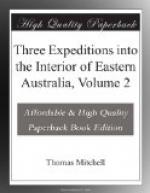Through the intervening valley flowed the Murray, the course of which was seldom visible as no trees grew along its border. Under such circumstances we could not encamp upon the bank, neither could it be safely approached by cattle; and our prospect of obtaining wood and watering our animals was this day rather uncertain. At length we came upon a path which Mr. Stapylton pursued amongst high reeds for a mile without reaching the river as we both expected. I continued to travel towards four trees on the side of a green hill, still at a great distance but in the direction in which I wished to proceed.
JUNCTION OF TWO BRANCHES. SWAN HILL.
When we arrived there just before sunset we had the good fortune to find close under the hill a bend of the Murray, and to discover the junction of another river or branch with it at this point. Within the margin we found a small pond quite accessible to the cattle, and behind the hill was an extensive flat covered with the richest grass. Here therefore we could encamp most contentedly beside a clear hill, always a desirable neighbour, and an accessible river. We were also thus enabled to determine the junction perhaps of two rivers, an important object in geography. The latitude was 35 degrees 19 minutes 43 seconds South.
The lesser stream was about 50 yards wide, but below the junction the main stream divided into two branches so that I was doubtful whether this might not be only the termination of an ana-branch. From the falling off of the bergs on the distant right bank, and the approach of a line of lofty trees from the same quarter, I was almost convinced that some junction took place thereabouts, as indeed the natives last seen had informed us. During the day columns of smoke arose behind us in the direction where we had seen these natives, and further eastward we perceived a widespreading conflagration, doubtless caused by them although this expression of ire troubled us but little so long as the flames did not approach our route. The scrubs now receded from the river, but the curious variety of acacias they contained still drew our attention towards them. We found this day several which were new. One with a rigid hard leaf, not in flower, resembled in many respects the A. farinosa met with two days later, but it was perfectly smooth in all its parts.* Another appeared to be related to A. hispidula, but with much narrower leaves without the ragged cartilaginous margin of that species.**
(Footnote. A. sclerophylla, Lindley manuscripts; ramulis angulatis glabriusculis, phyllodiis rigidis carnosis rectiusculis linearibus apice latioribus mucronulatis multinerviis glabris eglandulosis, capitulis 1-2 sessilibus glaberrimis.)
(**Footnote. A. aspera, Lindley manuscripts; phyllodiis oblongo-linearibus uninerviis mucronatis eglandulosis ramisque angulatis asperrimis, capitulis 1-2 axillaribus, pedunculis villosis phyllodiis duplo brevioribus.)




